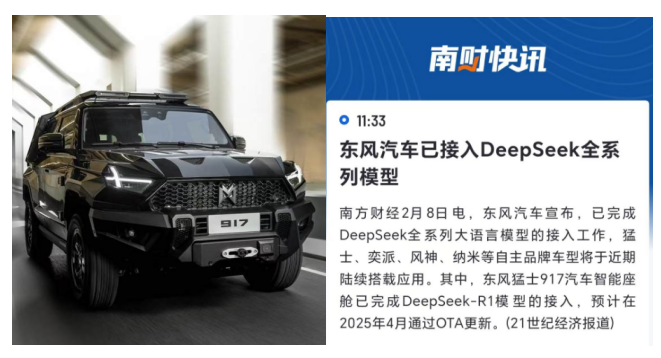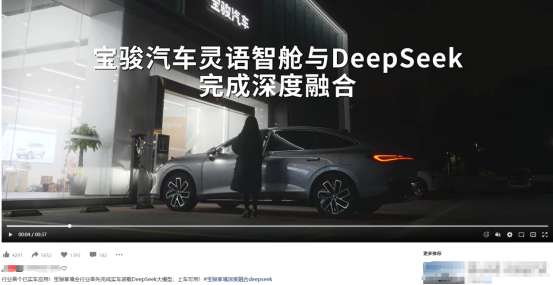Rolling into DeepSeek: Which Auto Company Claims the 'Industry First' in This AI Race?
![]() 02/10 2025
02/10 2025
![]() 524
524
During the 2025 Spring Festival Gala, the robot yangko troupe captivated the internet with their fluid movements and twirling handkerchiefs. Sa Beining quipped that the only thing missing from these robots was a pair of eyebrows. Notably, concurrently, 'DeepSeek Sweeping America' emerged as a trending topic. Zhou Hongyi released several videos discussing this event, boldly positioning 360 as an escort for DeepSeek.

These 'cybernetic possession' scenes signify a new pinnacle for China's technological advancements in AI, robots, drones, and artificial intelligence. Chinese auto companies have also jumped into the DeepSeek fray, igniting an AI battle.
Li Bin's Antics: Promoting Battery Swapping with DeepSeek?
Technically, the first 'automotive figure' to enter this realm was Li Bin of NIO. He hopped on the trend, using DeepSeek to emulate Mo Yan's style in crafting 'The Story of NIO Battery Swapping'. In this playful manner, he assisted the industry in testing DeepSeek's interactive capabilities. The outcome? Li Bin was thoroughly satisfied, and the internet was amused. Netizens even joked that Li Bin was subtly promoting battery swapping.
Although NIO hasn't officially announced its integration with DeepSeek, Li Bin can be credited with opening the door to this new race.

Thus, among auto companies, the race to enter and implement has commenced—all vying for the title of 'industry first'. It's safe to say that DeepSeek has accelerated the AI competition among Chinese auto companies...
The AI Battle Begins: Who Claims the 'Industry First'?
First up, Geely Automobile swiftly announced on February 7 that its self-developed Xingrui large model has achieved deep integration with DeepSeek-R1. It will commence distillation training for the Xingrui vehicle control Function Call large model, the automotive active interaction end-side large model, and others. Simultaneously, its subsidiary Zeekr announced the completion of deep integration between its self-developed Kr AI large model and DeepSeek-R1.

Next, Lantu officially announced its active cooperation with DeepSeek in the realm of smart cockpits, claiming that its Lantu Zhiyin is the first mass-produced model integrated with DeepSeek. This experience can be enjoyed via OTA upgrades on February 14. The focus here is on the landing model and timing.

Then, on February 8, Dongfeng Motor declared that its entire brand will soon be equipped with DeepSeek applications. Its Mengshi 917 smart cockpit has completed integration and is anticipated to be updated via OTA in April 2025. Consequently, Dongfeng Mengshi 917 has become the industry's first luxury new energy off-road vehicle equipped with DeepSeek.

Baojun released a video asserting that 'Baojun Xiangjing has pioneered the installation of the DeepSeek large model on actual vehicles' and demonstrated the voice cockpit function. In other words, Baojun Xiangjing is the industry's first model to implement the DeepSeek voice cockpit, and the video presentation is intriguing.

Moreover, IM Motors officially announced its access to DeepSeek and cooperation with large models like Doubao and Tongyi to jointly train and construct a multi-scenario pluggable AI matrix platform. Literally, IM Motors prioritizes breadth, capable of linking and training with other large models to form a versatile suite that meets the needs of the brand's entire vehicle lineup.

In summary, at this juncture, major brands are vying for the 'industry first' title in this new race, reflecting DeepSeek's low training costs and high implementation capabilities. Simply put, as long as a vehicle is equipped with a smart cockpit and the brand has accessed DeepSeek, advanced AI interaction functions can be obtained through OTA upgrades.
But a question arises: Is China's auto industry prepared to embrace the dawn of the AI era?

Can China's Auto Industry Embrace the Prematurely Arrived AI Era?
Certainly, it's unwise to forcibly enter the field merely to be the first to seize DeepSeek's dividends. As mentioned, while DeepSeek boasts low training costs and ease of implementation, it's meaningful only if high-quality data is used for training. Otherwise, it's merely training based on computational power and data scale, with interaction levels not significantly better than current AI voice interaction, failing to demonstrate a generational leap.
Secondly, when will DeepSeek truly be integrated into intelligent driving? This is currently the most crucial issue for Chinese auto companies to focus on. It's reported that DeepSeek currently employs dynamic distillation technology to derive small models from large ones. This approach is also utilized by mainstream intelligent driving enterprises, with the ultimate goal of 'distilling' the cloud-based large model to the planning end.

Some believe that since the principle is the same, relying on DeepSeek's low training cost will also reduce the demand for computational power. Thus, theoretically, it can be more easily introduced into model training for intelligent driving. But this brings us back to the previous question: there must be sufficient high-quality data.
Therefore, regarding the rise of DeepSeek, Chinese auto companies need to approach it rationally. Rushing to seize the initiative and capture public attention may not necessarily yield benefits. It might even lead to meaningless internal competition due to insufficient technological maturity to harness DeepSeek's advantages. So, compared to chasing traffic and heat, it's better to first lay a solid technical foundation for oneself.









